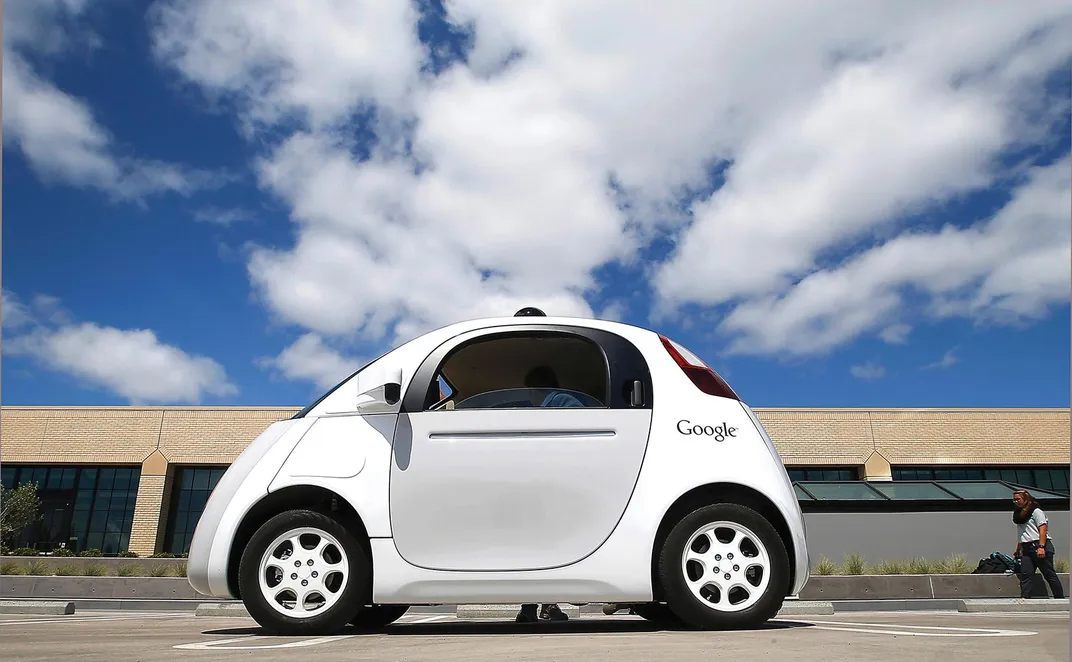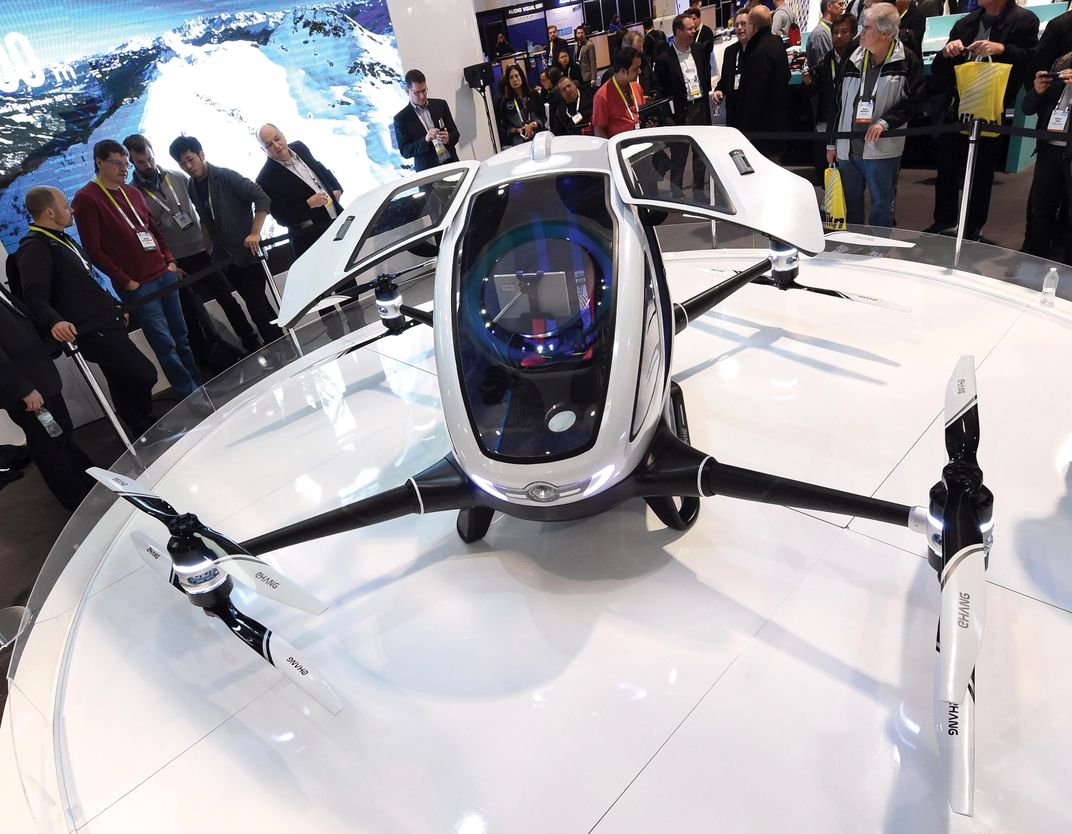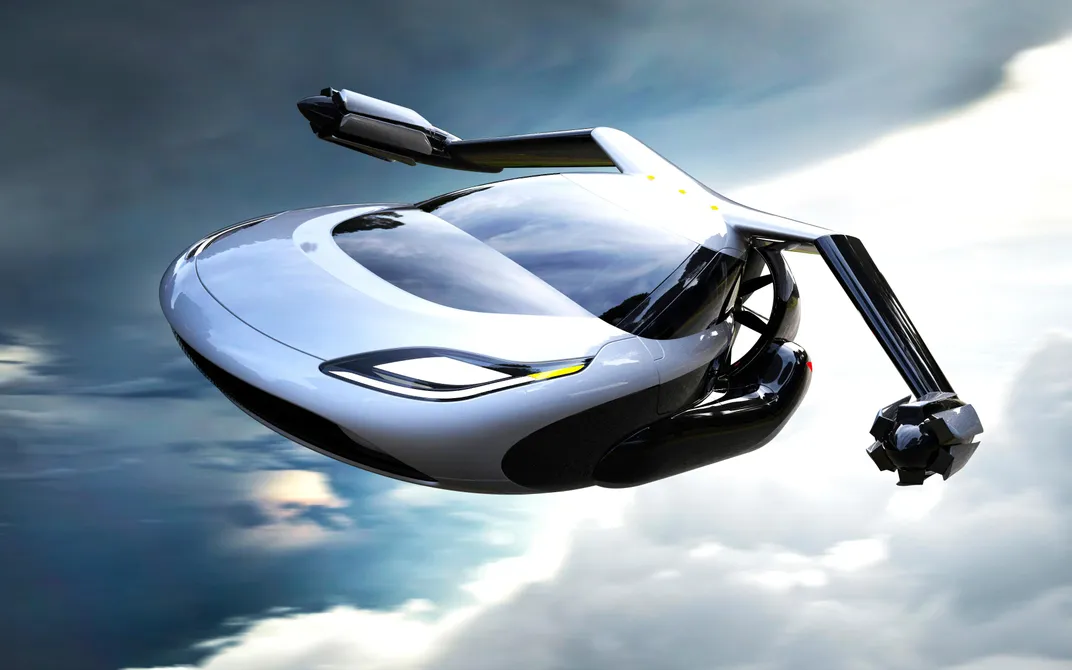The Future of Cars Is Already Here
Even before the “Jetsons,” people dreamed of flying cars. Now breakthroughs in technology are helping all kinds of vehicles get off the ground
/https://tf-cmsv2-smithsonianmag-media.s3.amazonaws.com/filer/29/53/29538285-5ec3-4c65-8419-b264af172de4/may2016_m03_flyingcars.jpg)
In the last hangar off the runway in Prineville, Oregon, Sam Bousfield locked down one of the wings to his flying car. His engineer was busy burnishing the parabolic slope of the carbon-fiber finish. Bousfield handed me half a tail wing. It floated in my hand, light as balsa wood. “Eight pounds,” he said, which, for a structural component of an airplane, is almost nothing. Off in the far side of the hangar sat his original wooden mock-up of the chassis, a three-wheeled aerodynamic lozenge right out of a manga enthusiast’s idea of a speed racer. He encouraged me to climb in and get a feel for the feng shui of the driver’s seat, the view out the windshield, the sense of balance. But what he really wanted me to see was that this thing was real—that the flying car is no longer in that jetpack realm of promising technology that never quite arrives. “I expect to take this car into the air in June,” he said.
The idea of flying cars has lingered in the back of people’s minds for decades, thanks to synapses permanently fused upon first seeing the opening credits of “The Jetsons.” The fantasy has been stymied by a handful of problems. Or, as the former vice chairman of GM, Bob Lutz, told me: “It’s the eternal dream, and nobody has ever been able to make it work.” Lutz is a smart, hilarious, cigar-smoking, gruff, anti-romantic skeptic whose view of this whole scene is why the English language has words in it like “harrumph.” He added, “You end up with the combination of a lousy car when it’s on the road and a lousier plane when it flies.”
But inventors like Bousfield are showing that they’ve begun to puzzle through some of the more vexing design problems that have kept this idea on the drawing board for decades. For instance, how do you stow the wings when you’re driving around town and yet keep your origami’d airplane from bulking up like some vehicular armadillo? In his first design, Bousfield engineered a retractable telescoping wing. But there was always that old problem: With lots of collapsing or folding, the smooth aerodynamic surface of the wing is compromised. Making it “roadable,” as flying car junkies call it, resulted in Lutz’s lousy plane. So working off the swing-wing design of an F-111 supersonic fighter bomber, Bousfield developed a full, aerodynamically sleek wing on a pivot that stows neatly and safely beneath the length of the vehicle. As a result, the prototype of Bousfield’s company, Samson Motorworks, looks like a supercool race car, with wings that spring outward from beneath the body at the press of a button, hence the name: the Switchblade.
And Bousfield’s not alone in searching for solutions to the problem. A century after Glenn Curtiss patented the Model 11 Autoplane (it never actually flew), around a dozen start-ups have jumped into the flying car competition. Sure, a few are little more than websites with vaporous computer-generated imagery. But most have real venture capital, prototypes and marketing plans. One of them, Terrafugia, founded by former MIT aerospace engineers and based in Massachusetts, is already taking orders on its flight-tested Transition model—a 20-foot-long aircraft with a steering wheel, gas and brake pedals for driving, and a stick and rudders for flying. The Transition’s wings fold up, as does part of the tail—it’s a foot shorter on the road—and the whole thing will fit into a standard house garage. Still, you’ll need a pilot’s license to take it aloft, along with at least 20 hours of flight training. Although it looks quite at home in the sky, on the ground it suffers the bulked-out problem, ambling down the road like some monster cricket escaping Chernobyl.
Still, in the larger realm of the things that get us around town, everyone is suddenly busy—from garage inventors to Detroit designers to bike mechanics to Google programmers. It is safe to say that we are living through the most intense frenzy of transportation creativity since the 1890s, when brothers Charles and Frank Duryea’s gas-powered buggy and Thomas Jeffery’s Rambler began spooking horses in Manhattan. Back then, one might happen upon all manner of experiments on any street corner. In 1900, the gas-fueled combustion engine was just one more concept car. About half the automobiles were steam-powered, and most of the taxis in Manhattan were electric.
Likewise, today we find ourselves in the midst of a Cambrian explosion of experimentation, with self-driving vehicles, hoverboards, maglev trains, biomass-mobiles, electric bicycles, hydrogen-powered vans, flying car prototypes and manned drones. Hardly a week passes without a gee-whiz story about a new steppingstone to our transformed future: Uber’s new R&D facility in Pittsburgh for autonomous vehicles, or a robotic new feature on a standard Detroit model (“adaptive cruise control,” say, a combination of radar and engine control that maintains a car’s position in traffic and keeps it in its lane) or some kind of sci-fi public transportation, like Elon Musk’s fantasy of a “hyperloop” train that would propel passengers at speeds up to 760 miles per hour via outsized pneumatic tubes.
I originally set out to clear a path through the hype by identifying the precise technological hurdles standing between us and a flying car. But I immediately stumbled over a presumption that most of us make—that the current flurry of inventions is on some linear track of improvement that will gradually take us past our souped-up combustion engine cars, on to robotic electric vehicles, and then to the flying car.
After spending time in inventors’ hangars, on the proving grounds of autonomous vehicles and even on my back, beneath a junker VW Cabrio I’d bought, I found that the contours of this revolution resemble a sort of traffic circle. So much depends on whether and when there are breakthroughs in artificial intelligence or energy efficiency or battery technology or even drone regulation. Any one of these off-ramps takes our transportation future onto a new path, and each involves a distinct set of philosophical dilemmas, cultural shifts and basic questions about how crowded we wish to see the roads around us and the sky above.
**********
A few years back, I met a professor at Gateway Community College, where I live in New Haven, Connecticut. Tony Rish teaches vehicle engineering with an emphasis on alternative energy sources. I asked him how hard it would be to tear the combustion engine out of my crummy old VW Cabrio, replace it with an electric motor, power it with lithium batteries and charge those off solar panels on the roof of my house. In other words: Could I build a car fueled entirely off sunshine? “That’s easy,” he said. “More or less.”
Rish is a mortar shell of a man, stout and ripped with the same weaponized head as Michael Chiklis of the TV show “The Shield.” He radiates an amicably infectious passion for cars. So, one chill weekend afternoon in Rish’s backyard garage in Middletown, Connecticut, we braked and chalked my Cabrio and spent most of a morning unhitching every connection in the engine bay. We wrapped the engine with sling belts and, deploying the magic of a winch, hoisted it out of there.
Afterward, we stood looking into the empty engine bay, ending the first of what became a year of weekends building a DIY energy-efficient electric car. I now run around town in it, and once I put up the solar panels to charge a battery pack—the kind Elon Musk recently announced Tesla will be manufacturing in Nevada—I will own a car powered entirely off daylight. The great American dream: a free ride, as long as you pay no attention to the $23,000 I’ve invested so far.
But the real reason I wanted to build this car is the same reason Sam Bousfield wants to build his, and, without sounding overly dramatic, it’s the underlying desire in all these designs. (Maestro, cue the national anthem.) It’s about a sense of freedom.
Bousfield’s desire to build a flying car grew out of a collaboration with Steve Fossett, the adventurer and the first man to circumnavigate the planet nonstop in a balloon. They intended to break the land speed record with a Bousfield design, but that project ended tragically when Fossett died in an accident aboard a small plane. “At that point, I had to reset what I was doing,” Bousfield said. “And I asked myself, ‘What’s wrong with aviation?’”
Planes get you places faster than anything else, he thought, but ultimately they’re not that useful, “because when you get there, you’re kind of stuck at the airport.” Bousfield wanted to unchain himself from the prescribed geography of 20th-century air travel. My longing to be free of visits to the gas station and fossil fuels in general brought me back to Rish’s backyard every weekend. The day I flopped onto Tony’s creeper, rolled under the back end of the car with a reciprocating saw and started chopping out the muffler, I felt as if I were making a break for it, heading to some newfound land. I loved cutting out the big hard plastic gas tank to make more battery room. It resembled some fossilized Jurassic placenta. I dragged the whole heap out to the trash pile. A new car was being born, at whose core was a battery system charged off a regular outlet in my driveway and, soon, by sunshine.
Battery technology is engulfed in its own revolution, marked by routinely breathless press releases announcing new devices capable of storing massive amounts of energy in seconds, of charging wirelessly, of breaking through to holy grail-like technologies (a “lithium-air battery,” for instance).
Mention big battery breakthroughs to Lutz, and the caustic exec turns into a tech-drunk evangelist. “Twenty years from now, I’d say, fully autonomous electric modules will be standardized so that they can be linked together,” he says. In Lutz’s near-future, cars won’t need much more than local battery range, because once they get on the freeway, they will automatically be assessed a toll for a charge. “There will be inductive rails embedded in the concrete or asphalt which will power that whole swarm of vehicles continually as they’re moving down the freeway,” he muses. “After you leave the freeway, your car will go the last 10 miles or 15 miles or 20 miles to your ultimate destination. And when you reach your destination, you get out, and your car will go to some sort of holding barn, where it will be recharged off of inductive current placed under parking spaces.”
If the fast-charging hyper-electric vehicle is still a breakthrough away, the cars of today are getting smarter. Nearly every new model from most manufacturers now offers “self-parking,” and some argue that new features on Toyota’s Lexus GS, with automatic steering and acceleration, smart braking, robotic lane changing and radar monitoring of surrounding traffic, means that the driverless car is effectively among us. Same with Tesla’s much-hyped “autopilot” feature, rolled out via a software update to its radar, sensor and camera-equipped Model S cars late last year: Already YouTube is rife with dozens of videos showing the car making its way robotically through real traffic.
Safety standards typically lag behind technology’s pioneers, but the U.S. Department of Transportation recently signaled that rules of the road may soon be changing. The proposed budget for federal spending released in January included a near $4 billion line item for real-world testing of automated cars over the next ten years. Anthony Foxx, the Secretary of Transportation, has cited the need to speed up the deployment of autonomous driving and other new technologies that, according to his department’s studies, could “eliminate 94 percent of fatal crashes involving human error.” In January, he pledged that within six months there will be federal “guidance on the safe deployment and operation of autonomous vehicles,” and many states have already legalized testing autonomous cars, including Nevada, California, Michigan, Florida and parts of Virginia.
What’s more, younger generations aren’t buying cars in the same numbers their parents did, and they don’t feel that old 20th-century need to drive. Why buy a car when you can just summon an Uber or, as nervous Detroit executives say, “engage mobility services”? A generation that can press a button to parallel-park will also see its driving abilities atrophy, and in time, insurance companies could require exorbitant rates for accident-prone manually driven cars, creating a ruthless market force that threatens to stampede old cars into retirement.
And would that be so bad?
**********
In an immaculate car shed at Stanford’s Dynamic Design Lab near Palo Alto, Chris Gerdes spends his days shuttling between his test tracks and his computer terminal. Gerdes is one of the leading engineers identifying novel problems facing autonomous driving and writing the code to solve them. He’s a tall, cheerful guy with a Buzz Lightyear grin (and chin) who grew up in North Carolina near the Charlotte Motor Speedway. It’s instantly clear that this is a guy who loves cars. Even his dadmobile, a station wagon, is a stick shift. With his zeal for racing, Gerdes has been asking this question: Why not program autonomous vehicles to maneuver like the finest human car drivers? At his outdoor track, Gerdes studies the skills of race-car professionals and then programs their best instincts into his robot cars’ software.
Gerdes is excited to show me his latest acquisition—an all-electric lithium battery conversion car, just like mine, only the installation is not in a beat-up Cabrio but a mint DeLorean so spotless you could probably perform surgery in the motor bay. It also happens to be fully autonomous. “This is Marty,” Gerdes says. “Multiple Actuator Research Test bed for Yaw control.” Also in the car bay are Shelley and Trudy, robot cars that Gerdes puts on the track to test their outer limits.
Most store-bought cars are built for average drivers and favor stability over control: Many of us, it turns out, would rather have big, heavy clunkers without the maneuverability of light-footed race cars, even if it means we can’t quite get around traffic or other obstacles as spryly as we might. “But expert drivers don’t have the same hierarchy,” Gerdes says. They regularly sacrifice stability for control in order to gain advantage on the road. Certain maneuvers may feel counterintuitive, and dangerous, to us non-daredevils—think of how hard it is to teach “turning into a skid”—but that type of reactive driving is exactly what Gerdes is programming into Marty, Shelley and Trudy. Cars designed with champion-level expertise, Gerdes believes, could eliminate entire categories of accidents.
Just getting down the street under normal conditions provides occasion for new ways of thinking. “Autonomous vehicles don’t eliminate human error,” Gerdes tells his students. “They shift it from the driver to the programmer.” Say you are driving down the road and a child suddenly darts in front of your car. You might hit the child, or you might swerve, hit a tree and hurt or kill a passenger or yourself. Any bad outcome would be tragic, but it would also be chalked up as a “terrible accident.” Lacking prior knowledge about the circumstances, you couldn’t react on anything except instinct. But “how many of us would like to think about our most stressful driving situations,” asks Gerdes, “and instead of solving those behind the wheel, would rather do it by sitting at a desk?” That’s both the opportunity, and the burden, of autonomous driving.
Part of what Gerdes does is huddle with a team that includes not just engineers and programmers but also moral philosophers, and what has emerged is an ethical framework, or set of decision trees. For instance, instead of asking, “What should a car do in Scenario X?” they ask a broader question: What is the car’s responsibility on the road?
“The first rule is that the vehicle should obey the rules of the road and it should not cause an accident with somebody who is following the vehicle codes,” he says. Then you have situations where another car is violating the rules of the road. So the next command becomes, “If I’m not going to harm the occupants of the vehicle and I can avoid a collision with other people who are doing the wrong thing, then the car should do that.” And so on. Fans of science fiction might be feeling a bit of déjà vu, since, as even Gerdes admits, his programming rules sound a lot like Isaac Asimov’s famous Laws of Robotics, written in 1942: “A robot may not injure a human being....”
Still, there will come times when a car will be unprepared for how to react—maybe it unexpectedly encounters what it reads as a herd of elephants, which a person would quickly identify as a parade. Gerdes’ current solution is for the car to safely pull itself over and turn over control to the “driver” by voice command or what is called haptic technology—a jiggle in the driver’s seat.
That might take some getting used to, as will the entire gestalt of riding in such a car. Wirelessly connected vehicles, for instance, might travel at 90 miles per hour only a few feet apart—and might suddenly brake or accelerate in conjunction with the entire conga line of cars in constant and coordinated communication. Consider how you might react if your car suddenly speeds toward an oncoming vehicle only to veer within two inches of it before performing a Richard Petty-like maneuver to avoid a collision—all because it knew the physics of the moment well enough to save your life.
Ford has already anticipated this scenario, sort of. In March, the company applied for a patent called the Autonomous Vehicle Entertainment System, which darkens the windows, lowers a screen to block the front windshield and shows movies precisely so that occupants don’t have to concern themselves with the vehicle’s navigation and movement in any way whatsoever. Gerdes expects people to get used to giving up control fairly quickly. “I doubt that people would necessarily need to get that acclimated,” he said. “If they’re happily in their automated vehicle, playing around with their iPad and the vehicle does something unusual, they might look up and say—‘Hey! What was that?’”
**********
Of course, airplanes have long used “detect and avoid” systems, and unlike cars they have three dimensions in which to maneuver. The objects that an aircraft has to anticipate, once it’s cleared takeoff, are mainly other aircraft, birds and weather. The technology to handle those, says Terrafugia’s co-founder and CEO Carl Dietrich, are practically off-the-shelf.
The more pressing technological hurdle for the flying car is taking off and landing. Terrafugia’s second-generation flying car, called the TF-X, will feature a vertical takeoff with helicopter rotors that lift the plane straight up in the air above tree and building heights to safe airspace, where a rear jet engine will propel it toward its programmed destination.
Instead of seeing human intervention as a mere safety net or transitional necessity, Dietrich has built it into his programming, believing that there are precise situations when quick advice from a human with eyeballs—even one without a pilot’s license—is invaluable. “People are very good at looking out the window and assessing, ‘It’s safe if I land here,’” Dietrich said. “For computers, it can be very hard.” If there’s any outstanding concern, the aircraft would be programmed to default to the nearest airport.
“I’d feel a lot safer in an autonomously piloted vehicle traveling through the air than I would in an autonomously driven vehicle on the road,” said Lutz, the automobile man who, when he was president of Chrysler, famously inspired a generation of dreamers with a concept car that redefined the SUV by driving a then-unheard-of thing called a Jeep Grand Cherokee up the stairs of the 1992 Detroit Auto Show and plowing it through a plate-glass window.
Bousfield, of Samson Motorworks, is already at work on a second generation of his Switchblade, also pilot-free, to adapt a military technique that permits extremely short takeoffs and landings. Using compressed air valves fired across the top of the wing, the technology gives the plane up to four times more lift capacity, meaning that “you can safely touch down and take off from a parking lot,” says Bousfield, who is collaborating on the project with researchers at Georgia Tech.
There is no question that flying cars will be expensive, especially at first, but, as Bousfield points out in his business plan, there are half a million licensed pilots in the United States and more than 800,000 outside of the country. And unpiloted flying cars, according to transportation analyst Roger Lanctot, will first find a keenly interested customer base among the world’s growing super-rich, who are already looking for ways to escape the miseries of ever-increasing ground traffic. “Look at São Paulo, Brazil, add in security concerns, and that would be the only way to get around, if you are in a certain strata of society,” Lanctot said. “That would be true in parts of the Middle East and India, to say nothing of Los Angeles and New York.”
In time, as their novelty wears off and the technology becomes cheaper, flying cars will find all kinds of uses. “Say you have a major catastrophe and you have to get people to a hospital as quickly as possible,” Lutz mused. “Wouldn’t it be wonderful to have autonomous, vertical-lift ambulances where you could put four or five people on a stretcher, close the glass lid on them and within minutes the thing lands at a hospital?”
If the programming advances that have given us self-parking cars and adaptive cruise control continue apace, our roads may see fleets of autonomous vehicles by the 2020s, and using a smartphone app to fetch a driverless car from a nearby lot and provide door-to-door service will seem as routine as hailing a cab or getting an Uber. Recent documents filed by Google suggest that the electric car the company is developing may feature a work-around for the crummy battery storage of current cars. The company has partnered with Hevo Power, which develops cordless car-charging technology. A car would need only enough juice to get around town and to a designated highway—Lutz’s dream—where wireless charging would keep the battery topped off even during a high-speed, driverless trip. If a breakthrough in battery or other energy-source technologies makes flying a driverless car over longer distances possible, the market could open up far beyond pilots.
And this is how the cultural shift happens. In our dreams, we civilians like to think in broad-stroke, science fiction terms. We believe the combustion engine car conquered the horse in one swift, technological, cinematic moment. The reality is that it took almost half a century, and happened incrementally, after lots of experimentation with alternative energy sources, early adoption by the wealthy of luxury cars and later by truckers with short-haul goods, and finally once the widespread paving of roads gave the combustion engine the edge over other means of long-distance travel. It’s natural to think of innovation as happening in some instantaneous transformative way, but the transition to our own future will likelier involve a great mix of evolving technologies—a transportation landscape populated with smart cars, autonomous cars and, muses Fernando Suarez, a professor at Northeastern University’s School of Business, “maybe flying cars for some longer distances, and much better public transportation, and a dedicated bike lane, too.” The revolution will come, but you may not notice it until it’s happened.
**********
At the annual Consumer Electronics Show, held in January in Las Vegas, visitors and tech analysts were quick to notice all the vehicles. BMW showed off its AirTouch “gesture control.” The Faraday Future FFZERO1 “electric hypercar” had an iPhone slot in the steering wheel that would personalize the car to your settings. There was Audi’s new E-tron Quattro, with dual electric motors and promises of “piloted driving” via “swarm intelligence.” (The electronics show is nothing if not a showcase for new buzzwords.) Mitsubishi had its Emirai, with 3-D display embedded in the windshield, side cameras to provide exterior views and a “telematics” system that uses real-time mapping data to alert the driver to road conditions ahead. VW’s electric minivan, called BUDD-e, boasts an improved battery system with a nearly 400-mile range on a single charge. Toyota’s FCV Plus has a hydrogen fuel-cell engine. The Aston Martin Rapide S is controlled largely by touch-screen. There was also a basic Chevy Bolt, an electric car with decent range whose most eye-catching feature was its cheap price: under $30,000.
One entry drew special notice this year, a prototype by a Chinese company called Ehang: a single-passenger craft with four quadcopter motors running on batteries. In other words, the first manned drone. Fully charged, the Ehang 184 currently provides 23 minutes of flying, although given the plus-or-minus aspect of any official battery time, I was in a full sweat just reading the specs.
But the Ehang 184 is a concept car, whose entire purpose is to put investors, customers and industry competitors on notice: A new class of unpiloted flying vehicle has left the drawing board. It’s 18 feet long but can be folded up and sidelined in half a parking space. It flies up to 62 mph and can gain altitudes higher than 10,000 feet, far above infrastructural obstacles such as bridges and power lines. Looking at the vehicle made you start to ask questions. How safe is it? Do I want these things flying over my neighborhood? Would I put my child inside one? How much fun would it be to pop across town in an Ehang—how easy?
There is no control system, no pilot’s joystick, no instrument inside the cockpit save a tablet for a passenger to plug in a destination before being whisked up and away. You could imagine climbing inside the glass bubble, and that’s when you realize that the Ehang looks familiar: It’s George Jetson’s car, only better. You don’t have to pilot it at all, and it’s not a cartoon.
Related Reads

Flying Cars: The True Story
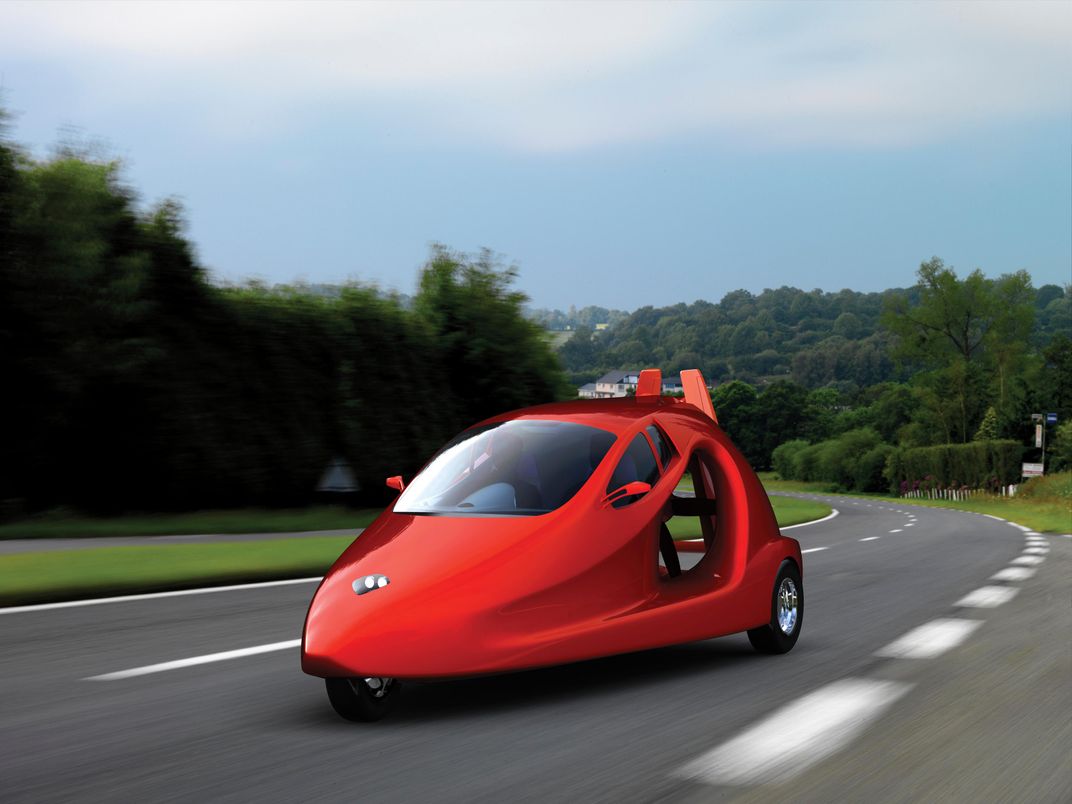
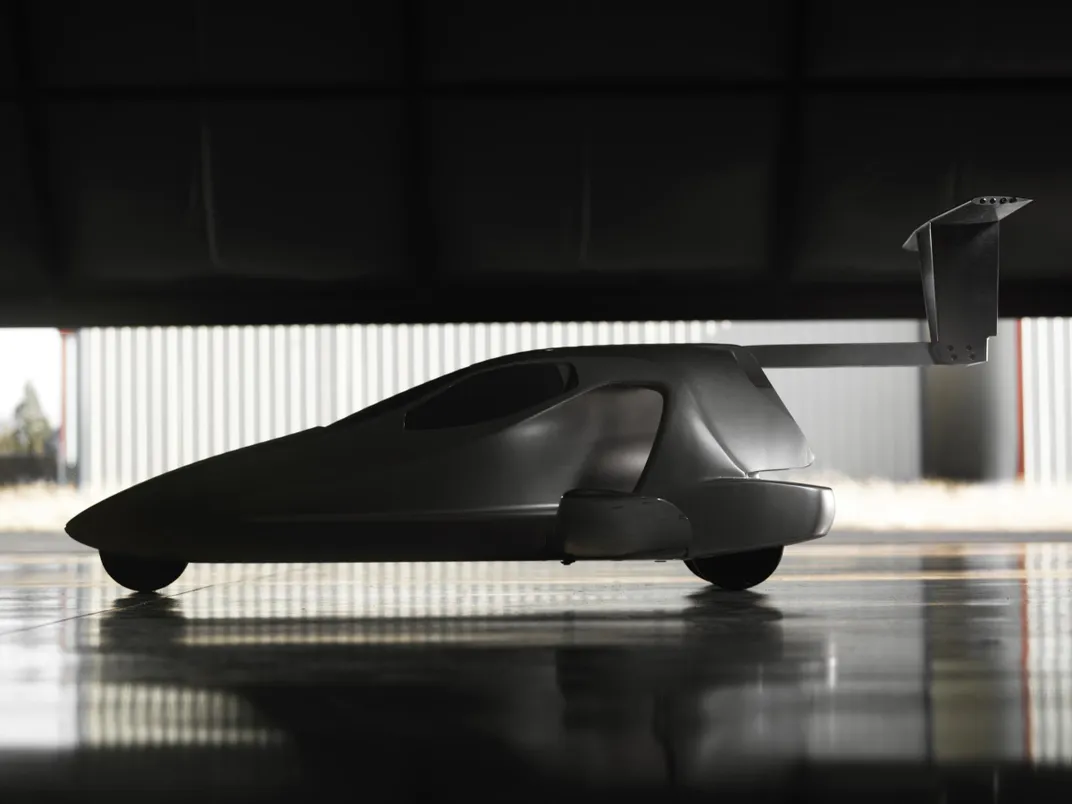
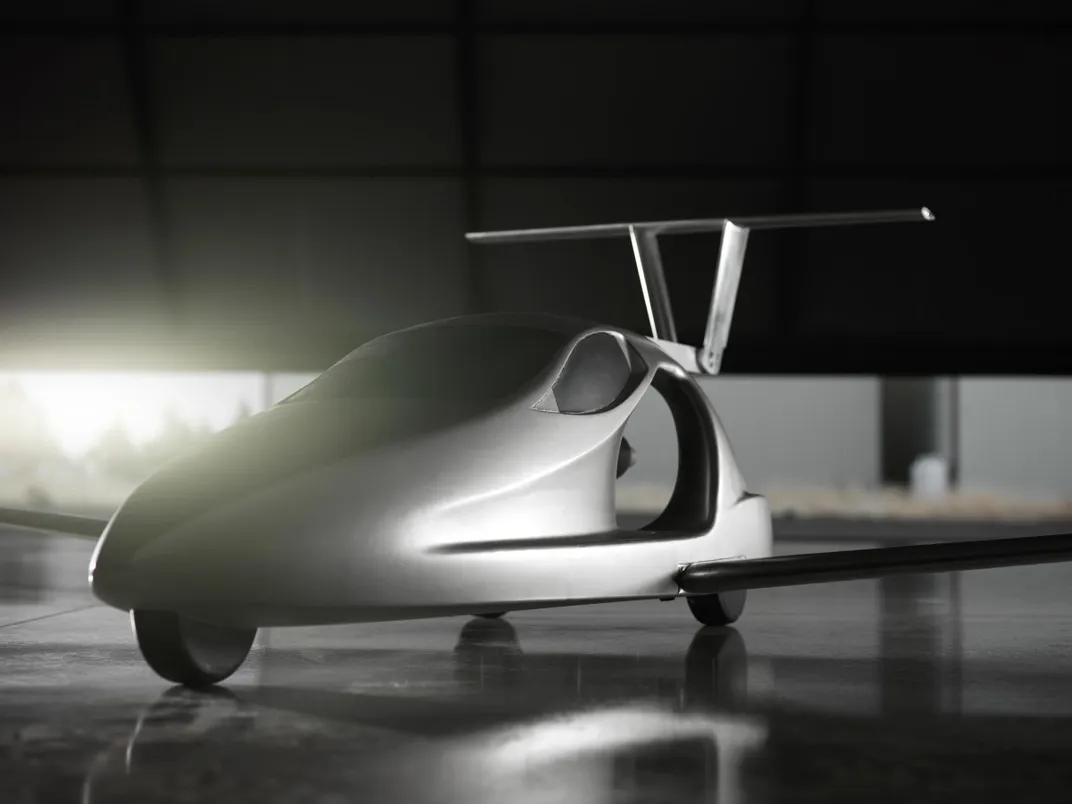
/https://tf-cmsv2-smithsonianmag-media.s3.amazonaws.com/filer/dd/53/dd537d5f-044f-4b1c-82c0-8b558004488d/may2016_m05_flyingcars.jpg)
